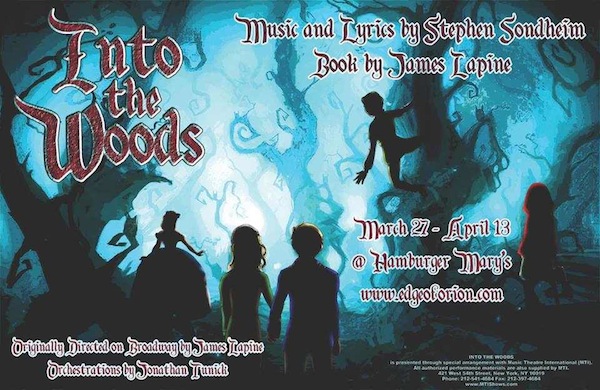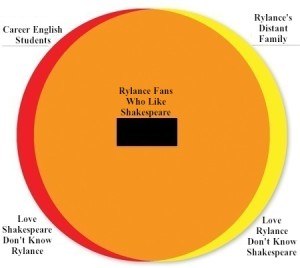 April 3rd kicked off the second weekend of EDGE Theatre’s Into The Woods, the classic Sondheim musical that needs no introduction. This show is no stranger to giant opera houses or Midwestern community prosceniums, but this production at Mary’s Attic showed me that the intimate spaces of storefront theater is where Into The Woods needs to be.
April 3rd kicked off the second weekend of EDGE Theatre’s Into The Woods, the classic Sondheim musical that needs no introduction. This show is no stranger to giant opera houses or Midwestern community prosceniums, but this production at Mary’s Attic showed me that the intimate spaces of storefront theater is where Into The Woods needs to be.
It’s the curse and blessing of Sondheim to sound effortless and simple when done well, and this cast proves that very point. The eponymous opening number started a little uneasily, with some unsure physicality and weak recitatives (a common symptom of second-week performances) but everything turned around with the explosively dynamic entrance of the Witch (Sarah Sapperstein). Whether cued off of her energy or simply falling into place around that time, the entire cast clicked, delivering easy-yet-powerful commitment until final curtain.
Herein lies the beauty of the intimate (meaning small) space. The fourth wall is a thin skein at best, as with many musicals, and when these performers sing to us, it’s like a well-mastered soliloquy: we are invited into their private thoughts. Given the gorgeously conversational nature of many of Sondheim’s songs, I shudder to see this musical again without that intimacy. Director Emma Couling seems to have a strong understanding of when the Masks we wear are down or up, and this is clearly shown when the characters choose to sing to us or over us; whether they are patter-singing or using sustain (this was particularly well demonstrated by Sarah Sarka’s Cinderalla).
The Baker and his Wife are generally considered the leads of this ensemble show, and Aaron Sarka and Sydney Ray provide subtly nuanced images of each. Sarka gives us a confident, strong portrayal of a very unsure and unconfident man who only finds his strength after losing (almost) everything. Ray gives the Wife a light touch, creating a soft and warm mother-to-be, who in turn becomes wilder and delightfully unsure in her closing scenes.
In a cast full of powerful physical commitment, special mention goes to Mario Aivazian’s Jack, who fires his focus like a gun in the first act, and the Princes (Stephan Scalabrino and Nick Toussaint): each man knows his role and plays it to the proverbial hilt, and when they share the stage it transforms into a laugh-factory. Sadly, Aivazian seems less sure with the subtleties of the second act, and Toussaint’s Prince Charming arguably loses an opportunity to show some dimension in “Any Moment” and “Moments In The Woods” (where Sydney Ray shines brightest). Both princes, however, hint gently in their final scenes that a greater complexity hides beneath their masks.
The jewels of this ensemble are Nick Stockwell’s Narrator and Sapperstein’s Witch. Stockwell alone maintains precise focus in the shaky first minute or two of the opening, creating a straight-line contrast throughout to the wilderness and passion surrounding him: his physical alterations when doubling as the Old Man were strong and natural. Sapperstein, in addition to her bottomless well of commitment, demonstrates an amazing vocal variety and strength to be envied by any character actor (and singer) and conjures shivers more than once in her solos.
Ashley Woods’ costume design serves to beautify, demarcate, and foreshadow. Jack’s dopey ‘getup’ from the comedic first act is replaced by something simpler, grayer, and darker in the complex second act. The Witch’s ragged mane and Commedia-esque mask distances us from the character while foreshadowing her transformation into a beautiful young woman (which elicited an admiring “Oh!” from the audience member behind me). The costumes triumphed most during the Wife/Charming duets, when Ray’s soft, muted dress contrasted with Toussaint’s sharp, glossy doublet. Despite my earlier commentary on the potential for complexity here, Toussaint’s direct veneer is marvelously echoed in his glamourous costume, and Ray’s muddied uncertainty (and pleasure) are likewise paralleled in her appearance.
The one failing in costuming was the Old Man. Simple additions to the Narrator’s clothing, all in the same colour pallet, were of little effect; and Stockwell (despite valiant efforts) was unable to overcome his striking appearance to instantly show us that he was playing a different person. Despite this, he and everyone else did look very good in their roles.
The set (designed/constructed by Stockwell) was simple, efficient, and functional: just how I like them. The levels provided the usual visual contrasts expected in musicals and prevented the unraked audience from being problematic. John Gleason Teske’s props were a perfect compromise between the set’s functionality and the costumes’ representational beauty. Milky White (who must be mentioned) was hilariously tiny, and her size was well utilized.
The Bakers’ Scarf also must be remarked upon. It was used to brilliantly moving effect by the Baker family. Some people deserve some medals for that one.
Into The Woods has been done and redone and done again, and surely everyone has an opinion on how it aught to be staged. This production is not for those who like their musicals full of flashy illusion and artifice, like the movies. Indeed, in Couling’s production even the blackouts are not total, and there is a seemingly deliberate attempt to remind the audience that we are watching a play with a message (which is, after all, what we’re doing). The actors do enter the audience space a bit too often (a mistake I’ve committed myself), but it’s a minor inconvenience that, once again, reminds you of your role in this performance: an active observer. The limitations of the small space and budget seem deliberately supplemented by James Lapine’s text; that, or Couling just knows how to use the script. Everything serves to create a diverse and very accessible story told by one entity to another.
Into The Woods is playing at Mary’s Attic (5400 N Clark Street) April 4th, 6th, 10th, 11th, and 12th at 7pm, with 3pm matinees April 6th and 13th. Tickets are $15. There is an easily accessible bar, and even a drinking game for those of us who know the show best.
I recommend this show heartily.











